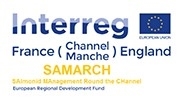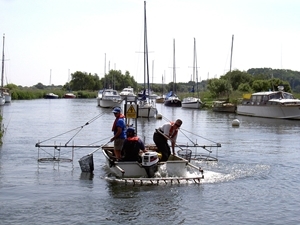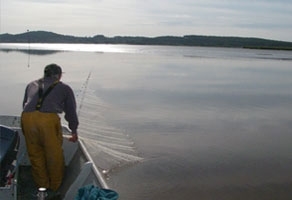 The GWCT is proud to be the lead partner on a major EU-funded programme that will provide vital research on rapidly declining salmon and sea trout (salmonid) populations. The work will focus on five rivers, estuaries and coastline in the Channel area: the Rivers Frome, Tamar, Scorff, Oir and Bresle. This internationally significant project will involve working with several other British and French institutions in a bid to halt and even reverse declining salmonid populations.
The GWCT is proud to be the lead partner on a major EU-funded programme that will provide vital research on rapidly declining salmon and sea trout (salmonid) populations. The work will focus on five rivers, estuaries and coastline in the Channel area: the Rivers Frome, Tamar, Scorff, Oir and Bresle. This internationally significant project will involve working with several other British and French institutions in a bid to halt and even reverse declining salmonid populations.
Why is new research needed?
 Atlantic salmon and sea trout populations have declined by as much as 70% since the 1970s. This project, known as SAMARCH (SAlmonid MAnagement Round the CHannel), aims to gather information on salmonid populations which will then be used to inform the management and protection of these populations in estuaries and coastal areas. The research will focus on several key areas including tracking the movements of salmonid populations in estuaries and coastal waters to determine what proportion of fish die in these areas.
Atlantic salmon and sea trout populations have declined by as much as 70% since the 1970s. This project, known as SAMARCH (SAlmonid MAnagement Round the CHannel), aims to gather information on salmonid populations which will then be used to inform the management and protection of these populations in estuaries and coastal areas. The research will focus on several key areas including tracking the movements of salmonid populations in estuaries and coastal waters to determine what proportion of fish die in these areas.
The project will use DNA analysis to map areas in the channel that are important for sea trout and gather novel information such as the sex of salmon using genetics to improve the tools used in England and France to manage our salmon populations.
Project Manager Dylan Roberts of the GWCT commented: “Until recently management has focused largely on addressing issues in freshwater. This is important because what happens in freshwater can often determine how many juveniles go to sea. However, we do know that around 95% of salmon that leave our rivers for their feeding grounds in the north Atlantic die once they have left the lower river, and this proportion has increased from around 70% when salmon were abundant in the 1970s. Recent developments in fish-tracking technology, DNA analysis and data modelling now enable us to investigate what proportion of this mortality occurs in the estuary and coastal areas, and their movements through these areas, then sharpen the tools used to manage salmon and adjust our management strategies accordingly. This work is particularly important because of the growth of coastal renewable energy schemes such as tidal lagoons and underwater turbines, which could harm fish. We are delighted that the Interreg Channel programme has decided to support our project and we look forward to working with our partners over the next five years.”
The project partners are:
- Lead Partner: Game & Wildlife Conservation Trust (UK)
- Institut National de Recherche Agronomique (France)
- Agrocampus Ouest (France)
- University of Exeter (UK)
- Bournemouth University (UK)
- Environment Agency (UK)
- Salmon and Trout Conservation (UK)
- Agence Française pour la Biodiversité (France)
- Normandie Grands Migrateurs (France)
- Bretagne Grands Migrateurs (France)
How can this research halt or even reverse this decline?
 Using contemporary science, the team aims to provide a basis for changes in the way juvenile and adult salmonids are protected and managed around our coasts and to improve the tools used by the regulatory bodies to manage salmon stocks. It is hoped that the information gathered from this five-year project (2017-2022) will then be used to push through changes in regulations in both France and England and potentially wider. This research project will ensure that the GWCT will become a key player in delivering evidence to inform the management of salmonids around coastal waters, which will include:
Using contemporary science, the team aims to provide a basis for changes in the way juvenile and adult salmonids are protected and managed around our coasts and to improve the tools used by the regulatory bodies to manage salmon stocks. It is hoped that the information gathered from this five-year project (2017-2022) will then be used to push through changes in regulations in both France and England and potentially wider. This research project will ensure that the GWCT will become a key player in delivering evidence to inform the management of salmonids around coastal waters, which will include:
- Netting regulation to protect salmonids from other fisheries
- Development of seasonal protected areas for salmonids
- Protection for salmonids from coastal developments e.g. tidal hydropower lagoons
- Provide novel data to improve the models used to manage salmon in England and France
The research is vitally important as Atlantic salmon and sea trout play a major role in coastal and river ecosystems, with juveniles providing a key source of food for other fish such as sea bass and lamprey, and for many other types of wildlife including sea birds, otters and seals. Salmonids also have a considerable economic importance, with their recreational value in Europe estimated to be as much as €1.2 billion.
More information about the funding of SAMARCH can be found on the project website.